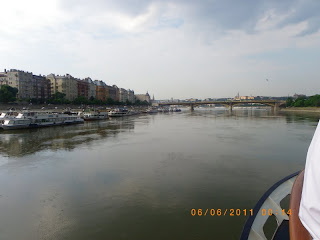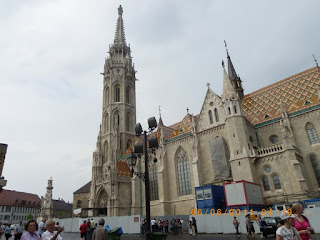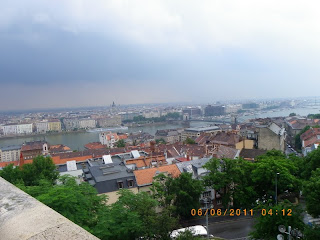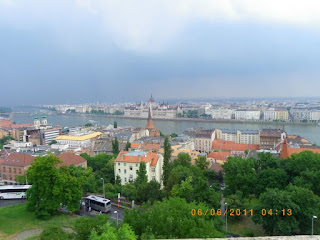 |
| Buda Hills on right |
 |
| Pest buildings on left |
 |
| Incredible Parliament buildings |
Pest is the largest area with a medieval centre which is still encircled by the wall built for defense against invaders. Today it is the commercial, financial and governmental centre.
 |
| Obuda section of Buda with Roman Ruins visible in the hills |
 |
| Church in the Rock on the Buda side. " Buda takes its name from Bleda the Hun ruler, whose name is also Buda in Hungarian." Bleda was the elder brother of Atilla and it is said that Atilla killed him because he named the conquered territory after himself. We heard that story from our city tour guide. If you look up the history of this era you will find many stories and who knows for sure what is real. The locals have their folklore. "Pest" is a word of Slavic origin that means oven. Buda was renamed Ofen at one time by the Germans and that means oven. There were many lime kilns there at one time. |
 |
| We docked with 2 other Uniworld ships, The River Empress and The River Beatrice, on the Buda side. |
Shortly after docking we boarded a bus with Andrea, another extremely entertaining and passionate guide with extensive knowledge. We drove across one of the bridges to the Pest side and Andrea pointed out significant landmarks and buildings. We drove up one of the most famous streets passing "The House of Horrors" which is a memorial to the atrocities of the war. Also in front is a memorial of the Iron Curtain and the Berlin Wall. We ended at Heroes Square which has awe-inspiring statues depicting the history of Hungary and Budapest. What a history it is too! Constantly occupied until recently.
 |
| I love Nivea cream and would have liked to visit this store! |
 |
| This is Andrea warning us about pick pockets. We did not get this warning often. |
 |
| Iron Curtain Memorial |
 |
| Berlin Wall Memorial |
 |
| This is supposed to be the world's fanciest Macdonald's Restaurant. The building is historically significant and if you google this you can see photos of the inside. |
We crossed one of the beautiful bridges and headed to Castle Hill where we strolled through what has been called "the heart of the nation."It is another Unesco World Heritage site and has more than 170 buildings dating back to the 13th and 14th centuries.
 |
| Visible bullet holes from the allies shooting at the Nazi occupied military barrack. |
 |
| Traditional Hungarian goods |
 |
| Of course...more cobblestone! |
 |
| Lovely cafes |
 |
| Contrast in styles |
 |
| Stark Communist style building |
We arrived at the St. Matthias church just in time for a thunderstorm. What an amazing place to take refuge. This church displays an incredible blend of architectural styles and influences from its time as a converted mosque to the baroque and gothic styles of the Catholic Church. Amazingly, through many periods of occupation, Hungarians have clung tenaciously to their Catholic Faith. Evidence of this deep faith can be seen everywhere as well as pride in their culture. Even modern teenagers wear traditional Hungarian Costumes during celebrations with pride, according to Andrea. Later back on board we saw a Hungarian Operetta and Folklore in the lounge. Outside the Cathedral is a famous statue of St. Stephen, the founder of Hungary.
After the storm blew over we went out to the Fisherman's Bastion, built in the 19th century in honour of the fishermen who defended Buda from the Turks during the Middle Ages. The view from there is panoramic but we didn't linger since lots of lightning was still in the sky. Walking back I noticed a "secret bunker" site.
Now back to the River Queen for lunch and then we walked on our own to the "Pedestrian Shopping Mall" and Central Market Hall on the Pest side. Wow!
 |
| Walking over to Pest |
 |
| Incredible Market |
 |
| Oh of course...we found a biergarten! Well we had to get out of the rain. |
 |
| Later on board...traditional Hungarian Folk Operetta |
 |
| Pedestrian Mall...several blocks of nothing but shops and stalls and cafes with the huge market at the end. |
 |
| You can see part of the old train building that now houses the amazing market. |





















No comments:
Post a Comment